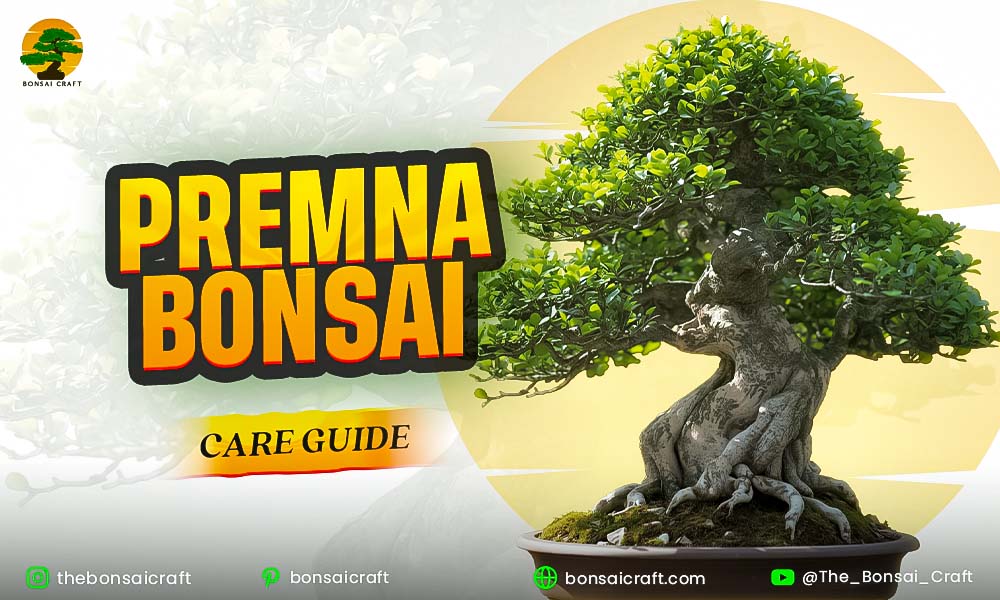
If you’re ready to explore the art of growing a Premna bonsai, you’re choosing a species revered for its textured trunk, small leaves and excellent ramification. This detailed Premna bonsai care guide will walk you through everything: from selecting a healthy bonsai Premna tree, to watering, fertilizing, pruning and styling. Whether you’re working with bonsai premna microphylla, premna japonica bonsai, or premna obtusifolia bonsai, these expert tips will boost your bonsai skills.
What Is a Premna Bonsai?
A “bonsai premna” is a miniature tree created from a species in the genus Premna, trained in pot form to reflect a full-sized tree shape but at a small scale.
Key Facts & Expert Insight
- The genus Premna belongs to the family Lamiaceae.
- Common species used in bonsai include Premna microphylla, Premna japonica, and Premna obtusifolia.
- According to a bonsai resource, “The most popular species for bonsai are Premna obtusifolia, Premna microphylla, Premna serratifolia and Premna japonica.”
Why This Species Works for Bonsai
- Small opposite leaves are ideal for scale and visual balance.
- Vigorous growth and strong root systems make them responsive to bonsai cultivation.
- Tropical/subtropical origin gives bonsai premna good adaptability for indoor/greenhouse or suitably warm outdoor conditions.
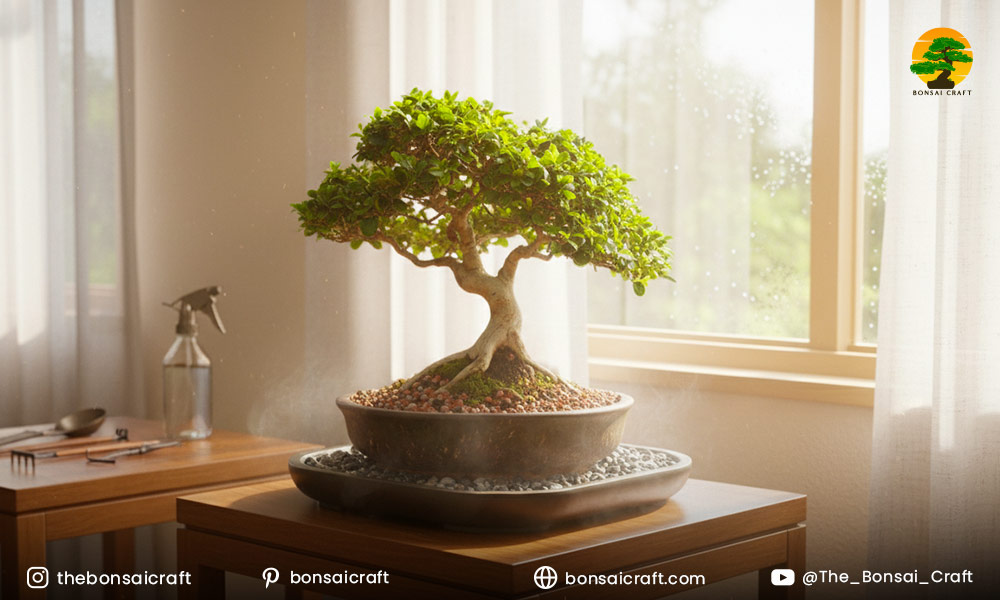
Perfect climate setup for healthy Premna bonsai growth
Ideal Growing Conditions for Bonsai Premna
Place your bonsai premna in bright light, warm temperatures, high humidity and a well-draining soil mix to mimic its subtropical roots.
Light & Placement
- Bonsai premna trees prefer full sun or very bright light, though smaller or weaker trees may benefit from morning light and afternoon shade.
- One care guide states: “Premna likes good aeration with full sun but be sure to protect them from the full glare of the midday sun.”
Temperature & Humidity
- As a subtropical species, they need to be kept above ~10 °C/50 °F. Cold sensitive.
- Indoors: a humid environment is preferred; use a humidity tray or misting if the air is dry.
Soil & Drainage
- Use well-draining bonsai soil, such as a mix of akadama, pumice and lava rock or coarse grit. Bonsai Empire emphasises that premnas “grow very strongly and produce a lot of roots… therefore they need much water and must not dry out completely.”
- Avoid heavy clay or puddled pots.
Expert Insight from Growers
One bonsai hobbyist noted:
“Added some moss to help it retain some moisture since premnas don’t like to fully dry out.”
Seasonal Considerations
- Summer: strong light, higher watering.
- Winter: keep soil slightly moist, avoid dryness.
Watering & Moisture Management
Water your premna bonsai thoroughly and regularly, ensuring soil stays evenly moist but never water-logged; never let it completely dry out.
Routine & Best Practice
- Water until water drains out of the pot’s holes to ensure full saturation.
- Check soil moisture regularly, especially in warmer months or if placed in bright light. Premnas tend to develop strong root systems and therefore demand moisture.
Winter Care
- In cooler seasons or when indoors, reduce watering frequency but don’t let the soil dry out. The tree is still respiring and root activity occurs albeit slower.
Warning Signs & Solutions
|
Sign |
Possible Cause |
Solution |
| Wilting or leaf drop | Soil drying out or low humidity |
Increase watering, raise humidity |
| Yellowing or root rot | Soil water-logged / poor drainage |
Repot into a better mix, improve drainage |
Expert Tip
Use a moisture meter or simply test by inserting a finger into the soil to the second knuckle. If still slightly moist, delay watering. Use 昃humus-rich small top-layer moss to help retain humidity in dry indoor climates.
Soil Fertility & Fertilising
Feed your bonsai premna regularly during active growth using a balanced or slightly nitrogen-reduced fertiliser; reduce feeding in dormancy or cooler periods.
Fertilising Schedule
- Growing season (spring through early autumn): Apply solid organic fertiliser every month or liquid fertiliser weekly per Bonsai Empire.
- Indoor or less active trees: Use liquid fertiliser once a month in winter.
- Some guides recommend: “Fertilizer should be applied at least once a month except during winter.”
Nutrients & Soil Health
- Use a general-purpose bonsai fertilizer, but ensure a good balance of N–P–K. Avoid high nitrogen levels in the late season to prevent weak growth.
- Consider micronutrients especially if growth appears pale or slow.
Expert Comparison
Compared with some tropical bonsai species that demand heavy feeding, bonsai premna is relatively forgiving but still benefits from consistent fertilising due to its vigorous root system and fast ramification.
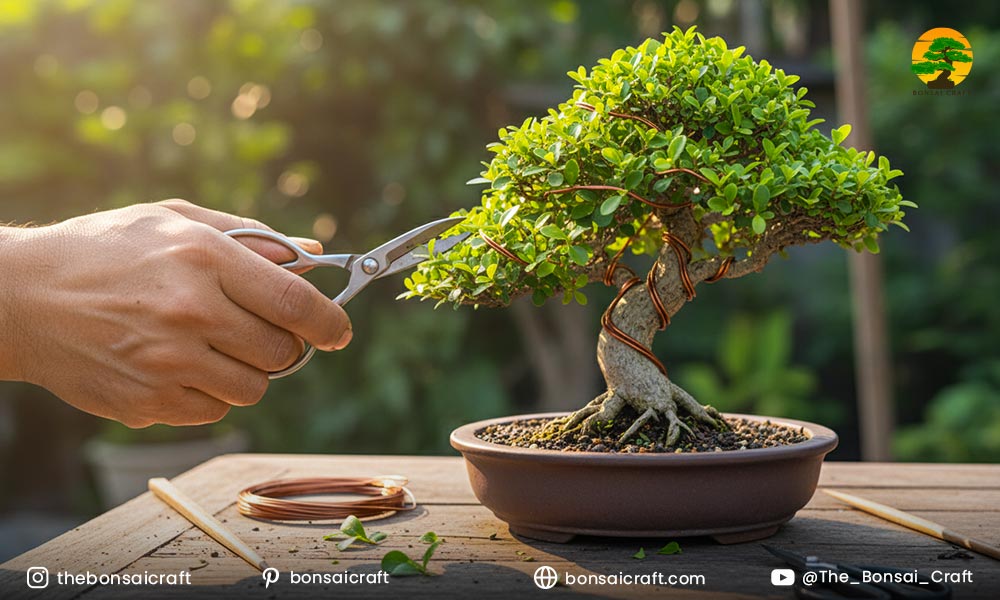
Shape your Premna bonsai for stunning bonsai form and balance
Pruning & Shaping the Premna Bonsai
Prune and wire your bonsai premna to maintain size, shape the structure, enhance ramification, and refine the foliage; major structural cuts are done during the active growth phase.
Structural Pruning & Wiring
- Larger branches are best pruned in summer when the tree is actively growing and wounds heal faster.
- New long shoots should be shortened to one or two leaf pairs when five or six have grown.
- Wiring is possible year-round for evergreen species but deciduous ones (like P. japonica) are best wired when leaves have dropped.
Maintenance Pruning & Leaf Reduction
- For fine ramification: pinch back new growth to maintain compact foliage clouds. One bonsai enthusiast advises reducing stems back to ~4 leaves when they reach ~6.
- Remove crossing or awkward branches; refine the silhouette.
Styling Considerations
- Good species for styles like informal upright (Moyogi), slanting (Shakan), or literati (Bunjin) due to elegant trunk lines and fine branching.
Expert Insight
In one blog:
“Premna microphylla is one of my favourite species. They bud back crazy, grow rather quickly, are forgiving, and are easy to reduce their leaves.”
That rapid re-budding is a great benefit when refining your bonsai.
Flowering & Fruiting in Premna Bonsai
While bonsai premna is primarily grown for form and foliage, some species produce small panicles of yellow-white flowers in summer, followed by tiny fruit; this enhances bonsai interest though fruiting is optional.
What to Expect
- Bonsai Empire notes: “In summer small panicles of yellow or whitish flowers can appear, followed by small dark fruit.”
- For bonsai-scale trees, flower and fruit production is lower but still achievable with proper health and vigor.
Enhancing Flowering
- Ensure strong root system, adequate fertiliser, full light and slightly cooler nights (if possible) to stimulate bloom.
- Avoid heavy nitrogen late in season which can promote vegetative growth over flowering.
Real-World Example
A Taiwanese grower of bonsai premna microphylla noted that after wiring and shaping the tree for 18 months, a small cluster of white flowers appeared in July — a clear sign of good health and care.
For Display
Giving bonsai premna seasonal cues (e.g., cooler nights or brief water reduction) can encourage bloom — but avoid inducing stress that could weaken the tree long-term.
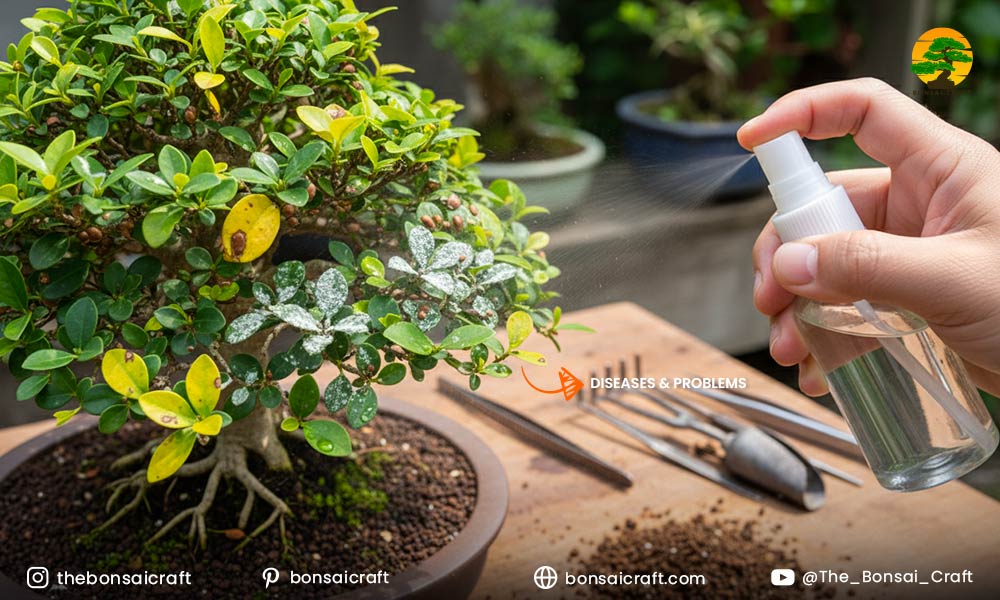
Keep your Premna bonsai pest-free and thriving
Common Pests, Diseases & Problems
Though generally resilient, bonsai premna can experience issues like scale insects, aphids, powdery mildew or root-rot from poor watering/soil—address promptly with cultural corrections and treatments.
Common Issues & Solutions
|
Problem |
Likely Cause |
Solution |
| Scale insects/aphids | Dense foliage, high humidity, low airflow | Prune the canopy, apply horticultural oil |
| Powdery mildew | Shaded, humid conditions | Increase sun & air, use sulphur spray |
| Root rot / yellowing leaves | Poor drainage or overwatering | Repot into free-draining soil, reduce watering |
Expert Note
Bonsai Empire states: “The Premna is quite resistant, but in rare cases aphids, scale, red spider mites or powdery mildew can occur. Then use a specific pesticide and try to improve the tree’s growing conditions.”
Preventive Practices
- Ensure good sunlight and airflow.
- Keep watering consistently but avoid saturation.
- Regularly inspect leaf undersides and branch intersections.
- Prune to open the canopy and improve ventilation.
Growing Premna Bonsai: From Seed vs Cutting/Graft
Most bonsai premna are propagated from cuttings or partially root-chopped nursery material; seed propagation is possible but less common due to slower growth and variability.
Propagation Methods
- Cuttings/Air-layering: Faster, retains parent features, ideal for bonsai.
- Seed: Longer time to develop trunk and ramification; variable leaf size and growth habits.
Expert Insight
Looping through bonsai forums, one grower wrote:
“Premna microphylla is a tropical species; they do well up to a sub-tropical climate.”
This indicates good adaptability of certain species for bonsai culture.
Species Variability & Selection
When choosing:
- bonsai premna microphylla: small-leaf, good for shohin/mini.
- bonsai premna taiwan (often P. obtusifolia or P. serratifolia): larger leaf but faster trunk development.
Understanding botanical names helps avoid confusion. One article comments on misidentification between P. microphylla and P. serratifolia.
Recommendation
For a beginner bonsai premna, choose vigorous nursery material, repot into bonsai soil in year one, focus on root health and branch structure, then refine styling over subsequent years.
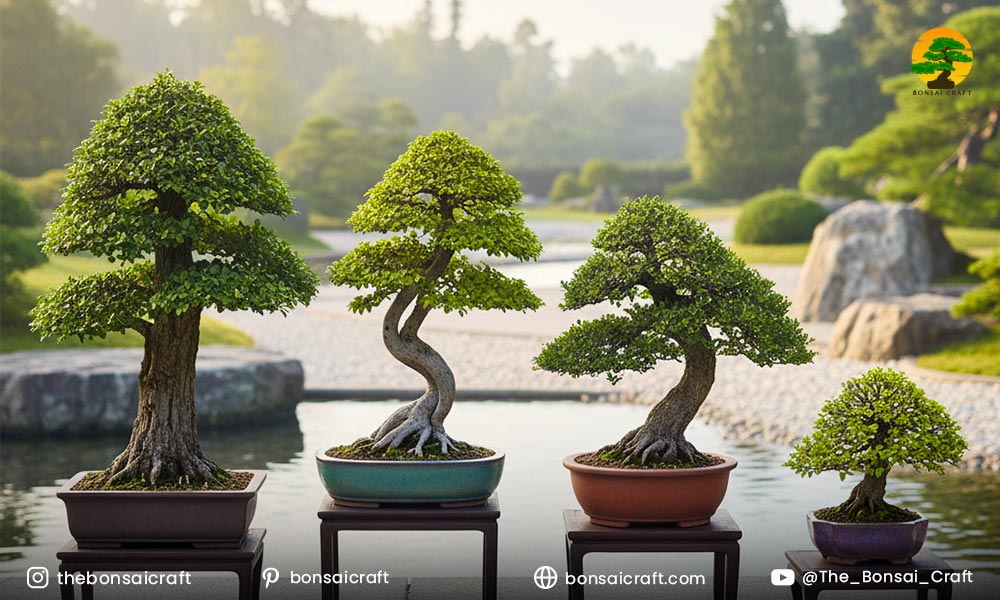
Explore artistic styling ideas for your beautiful Premna bonsai
Styling Options & Bonsai Premna Aesthetics
Premna bonsai respond well to a variety of styles—formal upright, informal upright, slanting, cascade—thanks to their flexible growth and textured trunk.
Popular Styles
- Informal Upright (Moyogi): The most common, leveraging natural trunk movement.
- Slanting (Shakan): Evokes a wind-swept tropic feel; Premna’s pliable branches suit this style.
- Shohin/Mame: Small-leaf species like P. microphylla excel as compact bonsai for indoors or balconies.
Real-World Example
In Taiwan and Indonesia, bonsai premna (especially P. microphylla) are widely used in shohin (small) collections for indoor or semi-outdoor display.
Artistic Considerations
- Use foliage pads (clouds) to emphasize branch structure.
- Consider exposed roots (“nebari”) for dramatic effect—Premna adapts well.
- Regular wire and trimming maintain scale and shape.
Conclusion
Mastering Premna bonsai care blends horticultural understanding with artistic finesse. Focus on good light, well-draining soil, consistent moisture, and thoughtful pruning—whether you’re using bonsai premna microphylla, premna japonica bonsai, or premna obtusifolia bonsai. With patience and care, your tree will develop beautiful trunks, refined foliage and a living aesthetic worthy of display for years to come.
FAQs about Premna Bonsai Care
How often should I water my Premna bonsai?
Water your Premna bonsai when the topsoil begins to dry. Maintain consistent moisture but avoid waterlogging, as excess water can lead to root rot. During summer, daily watering may be required, while in cooler months, reduce frequency depending on humidity and temperature levels.
What is the best soil mix for Premna bonsai trees?
Premna bonsai thrives in a well-draining soil mix of akadama, pumice, and lava rock. This mixture balances water retention with aeration, allowing roots to breathe and preventing rot. Adding organic compost occasionally helps improve nutrient availability and supports steady growth throughout the year.
How do I prune a Premna bonsai for a better shape?
Prune your Premna bonsai regularly during the growing season to maintain structure and encourage ramification. Trim long shoots, crossing branches, and dense foliage using sharp shears. Avoid heavy pruning in winter, and always seal large cuts to prevent infection and promote healthy new growth.
Can Premna bonsai grow indoors?
Yes, Premna bonsai can be grown indoors with proper care and attention. Place it near a bright window with indirect sunlight for at least 4–6 hours daily. Maintain good humidity and air circulation, and rotate the tree occasionally to ensure balanced light exposure and even leaf growth.
What are the common pests and problems for Premna bonsai?
Premna bonsai often faces pests like aphids, spider mites, and scale insects. Overwatering can also cause root rot. Regular inspection, proper watering, and organic pest control—such as neem oil or insecticidal soap—help prevent infestations and keep your bonsai healthy and vibrant year-round.
